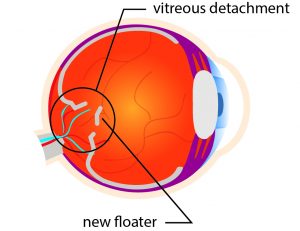
Floaters and Flashes
What are floaters?
The middle of the eye is filled with a clear gel called the vitreous. Opacities within the vitreous gel can form and “float” around, causing visible “floaters.” These floaters appear like dark or gray dots, lines, cobwebs, or clumps of debris moving in front of your vision. The floaters are more visible when you are looking into a bright light with a light background. Floaters are most noticeable when they first form, and tend to fade and become less visible with time. More than anything, your brain tends to “tune them out” after a few weeks.

What is a vitreous detachment?
A vitreous detachment is the most common cause of a new floater in middle aged people. It is a natural process that occurs in everyone as they get older. The vitreous gel slowly shrinks over time, then one day the lining tissue suddenly contracts and separates itself from the retina. A piece of this lining tissue then gets suspended in and floats within the vitreous gel, creating the new floater.

Why do flashes occur?
When the newly forming floater tugs on the retina, you may see a flash of light (when the retina is stimulated, you don’t feel pain, you see a light flash). The flash usually appears as an arc of light on the outer and/or upper part of your vision. It typically occurs when you are in the dark (driving at night or when you turn the lights out in a room), and lasts only a split second. Usually the flashes occur only for the first few days after the onset of a new floater, but sometimes they persist for several weeks or longer.
What are the risks of new floaters and flashes and a vitreous detachment?
When floaters form by pulling off the retina, a tear in the retina can occur, which may progress to a retinal detachment. A retinal tear or detachment are serious conditions that usually require surgery to repair and prevent loss of vision. This is why the sudden onset of new floaters, particularly with light flashes, requires a relatively urgent eye exam.
What are the symptoms of a retinal tear or detachment?
A retinal tear or detachment may occur in a small percentage of people with a new floater/vitreous detachment. Once a vitreous detachment starts, it takes around 4-6 weeks for the vitreous lining to completely separate and free itself from the retina. You are at particular risk for a retinal tear or detachment during that time. If a tear occurs, pigment and/or blood may be released into the vitreous, causing you to see a new shower of small dark floaters everywhere in your vision. In addition, flashes of light may become more frequent. If the retina detaches, you may see a shadow or dark area over a portion of your vision. Therefore, if any of the following symptoms occur, seek attention immediately:
- New shower of small dark floaters
- Increase in flashing of light
- A large shadow or dark area over a portion of your vision

Can floaters be removed?
There is a surgery to remove the entire vitreous gel and its contents. However, it is a serious surgery with many risks, and it is generally only done if there is a great deal of blood or infection in the eye. Because of the risks of the surgery, it is very rarely ever done to remove benign floaters. While the floaters may seem very annoying when they first appear, they do tend to fade and become much less noticeable over time.
Download our Floaters and Flashes Information Sheet:
Floaters and flashes_Info_Sheet_080518